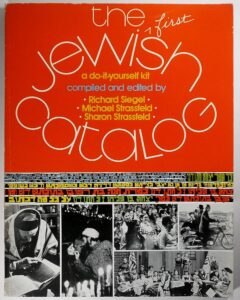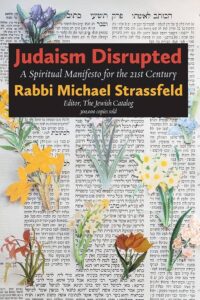Happy Birthday to you, Happy Birthday to you, Happy Birthday to The Jewish Catalog,. How old are you now?
This year The Jewish Catalog: a do-it-yourself kit reached the venerable age of fifty — right smack in middle age. When most of us reach that age, we show signs that we have arrived: some gray at our temples, a few wrinkles, maybe even a desire for a midday nap. But a fifty-year-old is hardly over the hill these days and may look forward to some of his or her best years.
 The same may be said of some books. Inspired by the 1968 Whole Earth Catalog, the First Jewish Catalog rode the do-it-yourself wave that began in the early 20th century, became a phenomenon in the 50s and 60s and peaked in the 70s to 90s.
The same may be said of some books. Inspired by the 1968 Whole Earth Catalog, the First Jewish Catalog rode the do-it-yourself wave that began in the early 20th century, became a phenomenon in the 50s and 60s and peaked in the 70s to 90s.
Reflecting the changes in the more liberal branches of Judaism, the catalog began as author Richard Siegel’s master’s thesis from Brandeis. It answered questions, gave instructions, and encouraged participation at a time when many young Jews were looking for new ways to connect with their Judaism.
The three twenty-something authors — Siegel, Michael Strassfeld and then wife Sharon Strassfeld — all went on to fulfilling carriers as both authors and rabbis.
Richard Siegel passed away in 2018. He is also credited with The Jewish Almanac, and, with his wife Rabbi Laura Geller, Getting Good at Getting Older.
 Author Michael Strassfeld, who became a rabbi, retired from the pulpit in 2015. He recently wrote Judaism Disrupted: a spiritual manifesto for the 21st century in which he argues that “Judaism purpose is to encourage and remind us to live lives of compassion, loving relationships and being a good person.”
Author Michael Strassfeld, who became a rabbi, retired from the pulpit in 2015. He recently wrote Judaism Disrupted: a spiritual manifesto for the 21st century in which he argues that “Judaism purpose is to encourage and remind us to live lives of compassion, loving relationships and being a good person.”
Sharon Strassfeld was instrumental in founding the innovative Abraham Joshua Heschel School in New York, creating a ceremony for newborn daughters and authoring The Jewish Family Book.
Many years after the Catalog’s publication, Siegel said the authors had “a legitimate critique of Jewish life and were offering some new ideas for its reinvigoration….we were working to make the change happen and providing the resources on how to live a Jewish live when the resources weren’t easily accessible.”
The First Jewish Catalog spawned two further books which focused more on the ethical, emotional and social issues of Judaism. Several catalogs aimed at young readers also appeared under Chaya Burstein’s authorship.
As columnist Jennifer Bleyer reflected some years ago in a Tablet Magazine article entitled Do it Yourself, The First Jewish Catalog is a true Jewish classic which has taught generations how to celebrate holidays, make a shofar, build a sukkah, crochet their own kippots, and connect or reconnect to their Judaism.
The First Jewish Catalog is the Jewish Publication Society’s second bestseller after the Bible. It is still in print. You might even have a dog-eared copy on your bookshelves or find it on your parents’.
It’s still worth dipping into. You may be charmed-or not — by the distinctly lowtech look. But it remains a valuable source for Jewish customs, ceremonies, recipes. And unlike the fickle internet — The Jewish Catalog is always ready to give you an answer.
The library has all three volumes, as well as, other books by the Catalog’s authors. There are also related volumes on the display shelves. The library catalog is available by a direct link from Shomrei’s home page.
- Not By Brains Alone - Thu, Jul 18, 2024
- Kudos to the Lampert Library - Thu, Jun 27, 2024
- Dairy Dishes Not Just for Shavuot - Fri, Jun 14, 2024



Aileen, I have all three on my bookshelf. They are literally falling apart. They are amazing. I am delighted to know they are still in print. Where may I purchase them? Jerilyn Margulies